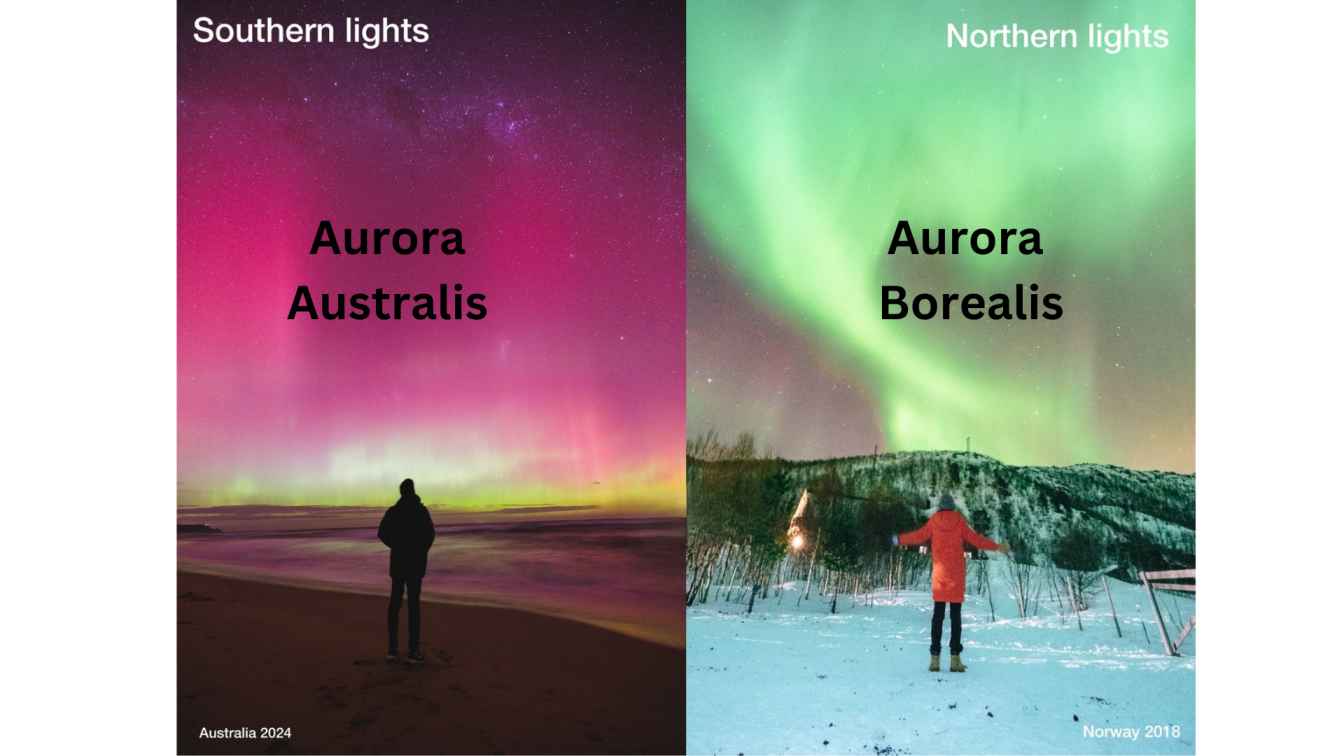Aurora Australis and Aurora Borealis:
The Aurora Borealis (Northern Lights) and Aurora Australis (Southern Lights) are beautiful natural light displays that occur near the Earth’s polar regions. They are caused by the interaction between the solar wind (charged particles from the Sun) and the Earth’s magnetic field.
👉 Aurora Borealis (Northern Lights) 🌌
- Location: Occurs in the northern hemisphere, particularly around the Arctic Circle (Canada, Alaska, Norway, Sweden, and Russia).
- Appearance: A stunning light display that appears in shades of green, purple, red, yellow, and blue, creating dynamic, shifting patterns in the night sky.
👉 Aurora Australis (Southern Lights) 🌠
- Location: Occurs in the southern hemisphere, primarily around the Antarctic Circle (southern parts of Australia, New Zealand, and the Antarctic region).
- Appearance: Similar to the Aurora Borealis, it features vibrant light displays, but is more rarely observed due to fewer human settlements near the South Pole.

How Are Auroras Triggered?
- Solar Wind ☀️
- Solar wind consists of charged particles (mainly electrons and protons) emitted by the Sun. These particles travel through space and reach Earth.
- When these charged particles (also known as solar energetic particles) collide with the Earth’s magnetosphere (the magnetic field surrounding the Earth), they are funneled toward the polar regions.
- Magnetic Field Interaction 🧲
- Earth’s magnetic field is strongest near the poles. As the charged particles from the solar wind move toward these regions, they interact with the magnetic field lines.
- The particles follow the magnetic field lines towards the polar regions, where they collide with atoms and molecules in the Earth’s atmosphere (primarily oxygen and nitrogen).
- Excitation of Atoms and Molecules ⚡
- When the charged particles collide with atmospheric gases, such as oxygen and nitrogen, they excite the atoms and molecules.
- As these gases return to their normal state, they release energy in the form of light, creating the colorful aurora displays we see in the sky.
- Color Variations 🌈
- The colors of the aurora depend on which gases are involved and the altitude at which the collisions take place.
- Green is the most common color, caused by oxygen atoms at about 60 miles above Earth.
- Red auroras occur at higher altitudes (above 150 miles), also due to oxygen atoms.
- Blue and purple colors are produced by nitrogen molecules and are more commonly seen at lower altitudes.
- The colors of the aurora depend on which gases are involved and the altitude at which the collisions take place.
Factors Influencing the Strength of Auroras
- Solar Activity 🌞
- The intensity of auroras is linked to the solar cycle, which lasts about 11 years. During periods of solar maximum (when solar activity is high), auroras are more frequent and vivid.
- Coronal mass ejections (CMEs), which are massive bursts of solar wind, can significantly increase the strength of auroras.
- Geomagnetic Storms 🌩️
- Geomagnetic storms occur when solar winds are particularly strong and disturb the Earth’s magnetic field, resulting in brighter, more intense auroras.
In Summary:
- Aurora Borealis occurs in the Northern Hemisphere and Aurora Australis in the Southern Hemisphere.
- Both are triggered by interactions between solar wind, the Earth’s magnetic field, and atmospheric particles, producing the vibrant, colorful light displays seen near the poles.
Disclaimer: We apologize for any errors or inaccuracies that may have occurred. 🙏 Please let us know if you find any mistakes so we can correct them. (contact@6to12teach.co.in)
